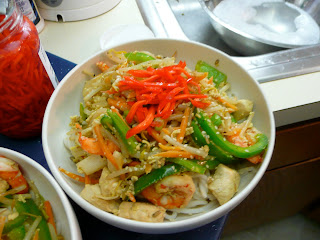Tuesday, June 8, 2010
Yaki Soba
If you're looking at the title of this post and thinking that it sounds a little off for this blog, you're right. Yaki soba is very definitely not anything my grandmother, or her mother, would have recognized. It is, however, my favorite dish from my favorite UK restaurant, Wagamama (which now has locations in Boston and Washington, DC--why nothing in New York I still don't understand!). Wagamama takes Japanese cuisine and puts its own spin on it. Since I have to travel pretty far to get my grubby mitts on the real thing, I have both Wagamama cookbooks, but I never had the nerve to try making yaki soba myself until two things happened:
1. I found beni shoga--also known as pickled red ginger--at my local Asian market.
2. I had a houseguest from China who loves to cook.
Yaki soba isn't Chinese, of course--it's very definitely Japanese--but I figured an Asian cook would take to it more naturally than I might. In the end, it was relatively simple and I probably should have been brave enough to give it a whirl on my own. It was more fun to do it this way, though.
Without further ado, I present the recipe from Wagamama: The Way of the Noodle (which has a recipe looks more accurate to my experience than the Wagamama cookbook does--the recipes are, for some reason, not the same, and I can say without hesitation that sushi ginger is not only NOT the same as beni shoga, but would be vastly inferior in this recipe). It's now out of print, from the look of things, probably superceded by the later cookbook.
Yaki soba
200g cooked ramen noodles
For the topping:
1/2 onion, thinly sliced into half-moons
30g (or a handful) shredded carrots
100g beansprouts (the large ones--not alfalfa sprouts)
30g (or a handful) thinly sliced green pepper
50g shredded cooked chicken
6 cooked shrimps
1 egg
For the seasoning:
1 dessertspoon light soy sauce (for those in the US, this is a soup spoon from your silverware set)
1/2 teaspoon salt
1 teaspoon mirin
a few drops of sesame oil
For the garnish:
pickled ginger (beni shoga)
sesame seeds
1 spring onion, finely chopped
Put all the ingredients, except the egg, into a bowl with the seasoning and mix them with your hand. Then crack the egg into the bowl and mix it thoroughly.
Heat a couple tablespoons of vegetable oil in a wok or frying pan until the oil starts to smoke.
Put the mixed ingredients into the hot pan and fry until golden, turning occasionally with a wooden spoon.
Turn the cooked noodles onto a plate, garnish with pickled ginger, sesame seeds, and spring onions. Serves 1.
A few notes now that I have some experience with this recipe:
My Asian chef and I bought fresh noodles at the market that were labeled "Plain noodles." These turned out not to be what we wanted. She estimated, after I saw how stretchy and soft these noodles were when cooked (and how easily they stuck together, forming a giant clump) that we wanted lo mein noodles instead, since we couldn't find anything else that looked like fresh ramen at the market. The cookbook notes that, despite the name, this dish is not actually made with soba noodles, though I imagine they could be substituted without trouble. In any case, 200g is far too much. Our package of noodles was a little more than 400g and we fed three people with it quite easily.
It's also important to note that this recipe supposedly serves one. After cooking it, we decided there was a reason for that--namely, that cooking all the "topping" ingredients is quite difficult even in a large wok like the one I have. It would have been much easier to do two batches rather than doubling the ingredients like we did. Still, it's safe to assume that the topping ingredients, in the quantities stated above, along with about 200g of noodles, can safely feed about 1.5. If you want to feed a larger group, you'll want to do the stir-frying in batches.
We decided that the egg would have been better cracked into the wok rather than mixed in with the rest of the ingredients. We got very tiny bits of egg that way, which we suspect isn't what should have happened. Of course, I think we also only used one egg, which probably didn't help.
We had no sesame oil, and it turned out just fine. We were unable to find mirin at the Asian market, but did come up with something called Aji-mirin, which we used instead. As far as I could tell, it made no difference. I also sliced the spring onions rather than chopping them.
And finally, just for the record, beni shoga is deep red ginger--almost a dark pink (you can see it in the photo up top, on the very top of the noodles)--and is the same size and shape as the shredded carrots. The first time I had it, I wondered what they'd done to the carrots to make them so wonderful. Now I know--they're not carrots at all. While my Chinese friend said she could happily have done without it, the rest of us agreed that it was critical to the dish and is really our favorite part.
Subscribe to:
Post Comments (Atom)


No comments:
Post a Comment